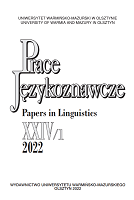Językowe wykładniki niebinarności płci w polszczyźnie. Część 2: Innowacje a system i tendencje rozwojowe
Linguistic markings of non-binary gender in Polish. Part 2: Innovation vs. systemic rules and evolutionary tendencies
Author(s): Małgorzata Gębka-WolakSubject(s): Language studies, Gender Studies, Theoretical Linguistics, Western Slavic Languages
Published by: Wydawnictwo Uniwersytetu Warmińsko-Mazurskiego w Olsztynie
Keywords: contemporary Polish; gender in language; non-binary language; language evolution; evolution patterns in Polish;
Summary/Abstract: The paper provides the second part of the analysis concerning possibilities of neutralizing the binary gender opposition and/or expressing non-binary gender in Polish. The focus is on different language innovations proposed at the zaimki.pl Internet portal. They were divided into those related to word-formation, inflection, and lexis. Taking into consideration the binary/non-binary and neutral/non-neutral privative oppositions, the article offers an expanded vision of the semantic category of gender. Then, a juxtaposition is offered of the traditional (masculine, feminine) and innovative (non-binary, neutral) gender markings in Polish. The article concentrates on those features of non-binary language which make it harder to implement those solutions in contemporary Polish. Those features include: a great number of linguistic means, often introduced in an arbitrary way; their variative and facultative nature; the fact that those means may be chosen among others on a purely individual basis; finally, the limited role played by internal factors which are normally decisive for language evolution. At the same time, we put forward a hypothesis according to which Polish will indeed evolve towards becoming more inclusive, influenced by social needs. We may cautiously predict that innovations likely to become accepted in general Polish are those of systemic nature, i.e., those employing already existing solutions, although they have different functions or scope of use, or duplicating existing mechanisms.
Journal: Prace Językoznawcze
- Issue Year: 24/2022
- Issue No: 1
- Page Range: 101-116
- Page Count: 16
- Language: Polish

